Algonquin College: Breezy Auto Parts Market Entry Case Study, MGT1103
VerifiedAdded on 2022/02/04
|24
|7814
|43
Case Study
AI Summary
This case study examines Breezy Auto Parts, a North American manufacturer of auto parts, and its need to redefine its market strategy due to declining sales and the shift towards fuel-efficient vehicles. The analysis includes SWOT and PESTE analyses to evaluate the company's strengths, weaknesses, opportunities, and threats, particularly in the context of international expansion. The core problem addressed is Breezy's decision on whether to focus on its existing North American market or expand into new international markets, considering financial constraints and the changing automotive landscape. The study recommends a strategic alliance in the South American market, specifically Brazil, as the most suitable entry strategy. This approach leverages Brazil's established automotive industry and lower reliance on electric vehicles compared to other markets. The report details the advantages, disadvantages, and implementation steps, including a timeline, to make the business idea achievable and provides evaluative criteria such as opportunity, market attractiveness, connection, finance, and macro-environment factors to assess the market entry strategy. The case study concludes that focusing on the South American market provides the best opportunity for Breezy to expand its business and tackle the present financial crisis.
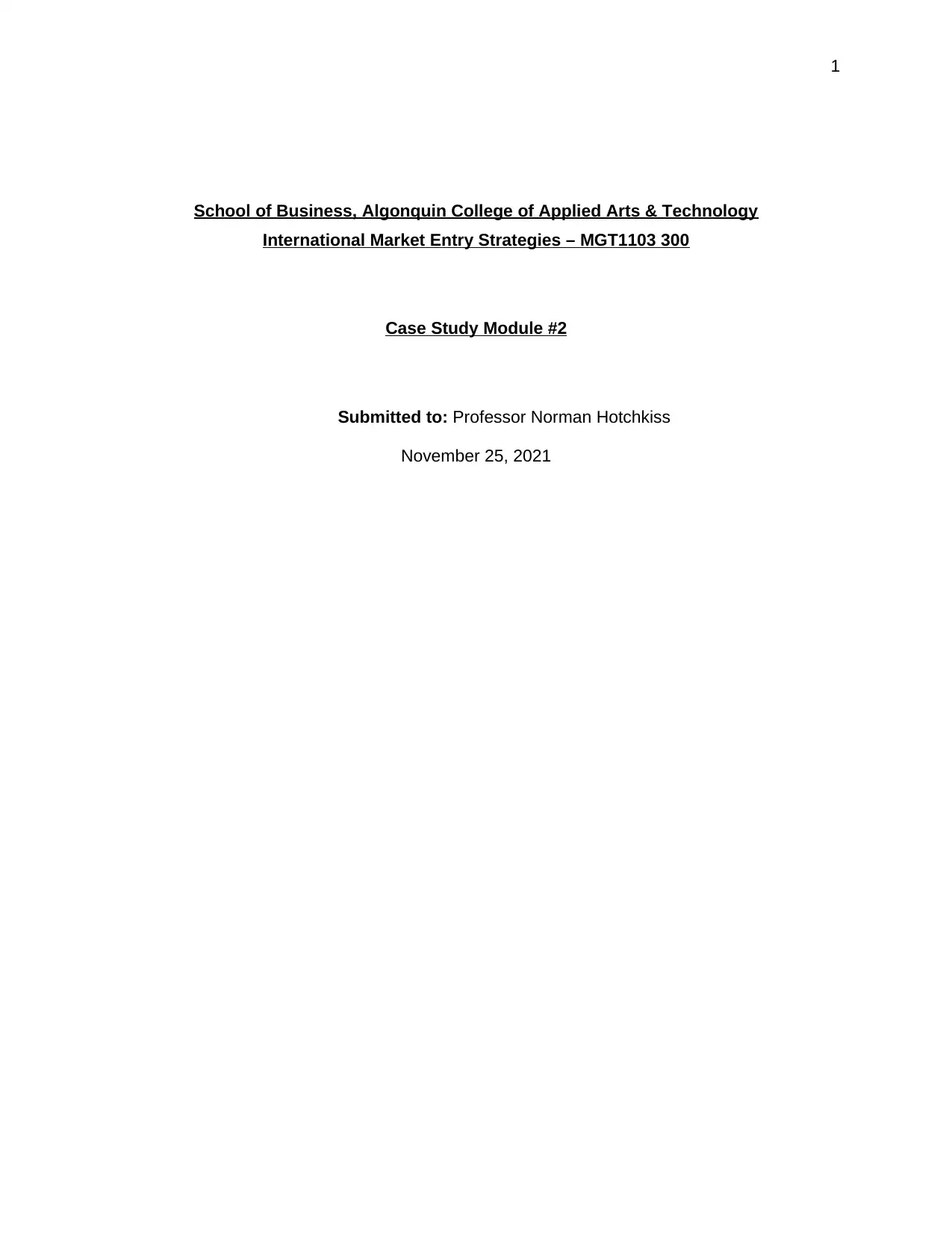
1
School of Business, Algonquin College of Applied Arts & Technology
International Market Entry Strategies – MGT1103 300
Case Study Module #2
Submitted to: Professor Norman Hotchkiss
November 25, 2021
School of Business, Algonquin College of Applied Arts & Technology
International Market Entry Strategies – MGT1103 300
Case Study Module #2
Submitted to: Professor Norman Hotchkiss
November 25, 2021
Paraphrase This Document
Need a fresh take? Get an instant paraphrase of this document with our AI Paraphraser
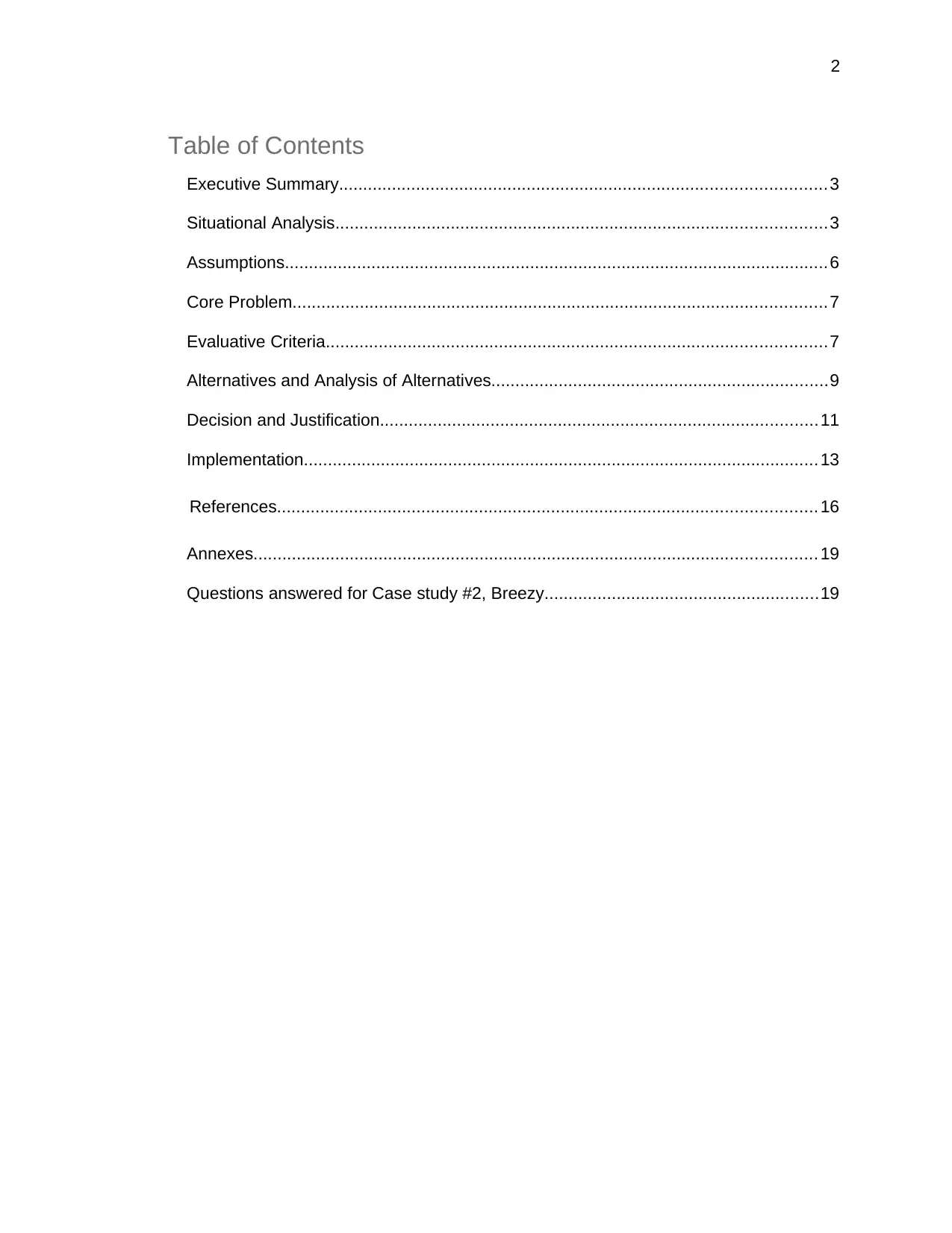
2
Table of Contents
Executive Summary.....................................................................................................3
Situational Analysis......................................................................................................3
Assumptions.................................................................................................................6
Core Problem...............................................................................................................7
Evaluative Criteria........................................................................................................7
Alternatives and Analysis of Alternatives......................................................................9
Decision and Justification...........................................................................................11
Implementation...........................................................................................................13
References................................................................................................................ 16
Annexes..................................................................................................................... 19
Questions answered for Case study #2, Breezy.........................................................19
Table of Contents
Executive Summary.....................................................................................................3
Situational Analysis......................................................................................................3
Assumptions.................................................................................................................6
Core Problem...............................................................................................................7
Evaluative Criteria........................................................................................................7
Alternatives and Analysis of Alternatives......................................................................9
Decision and Justification...........................................................................................11
Implementation...........................................................................................................13
References................................................................................................................ 16
Annexes..................................................................................................................... 19
Questions answered for Case study #2, Breezy.........................................................19
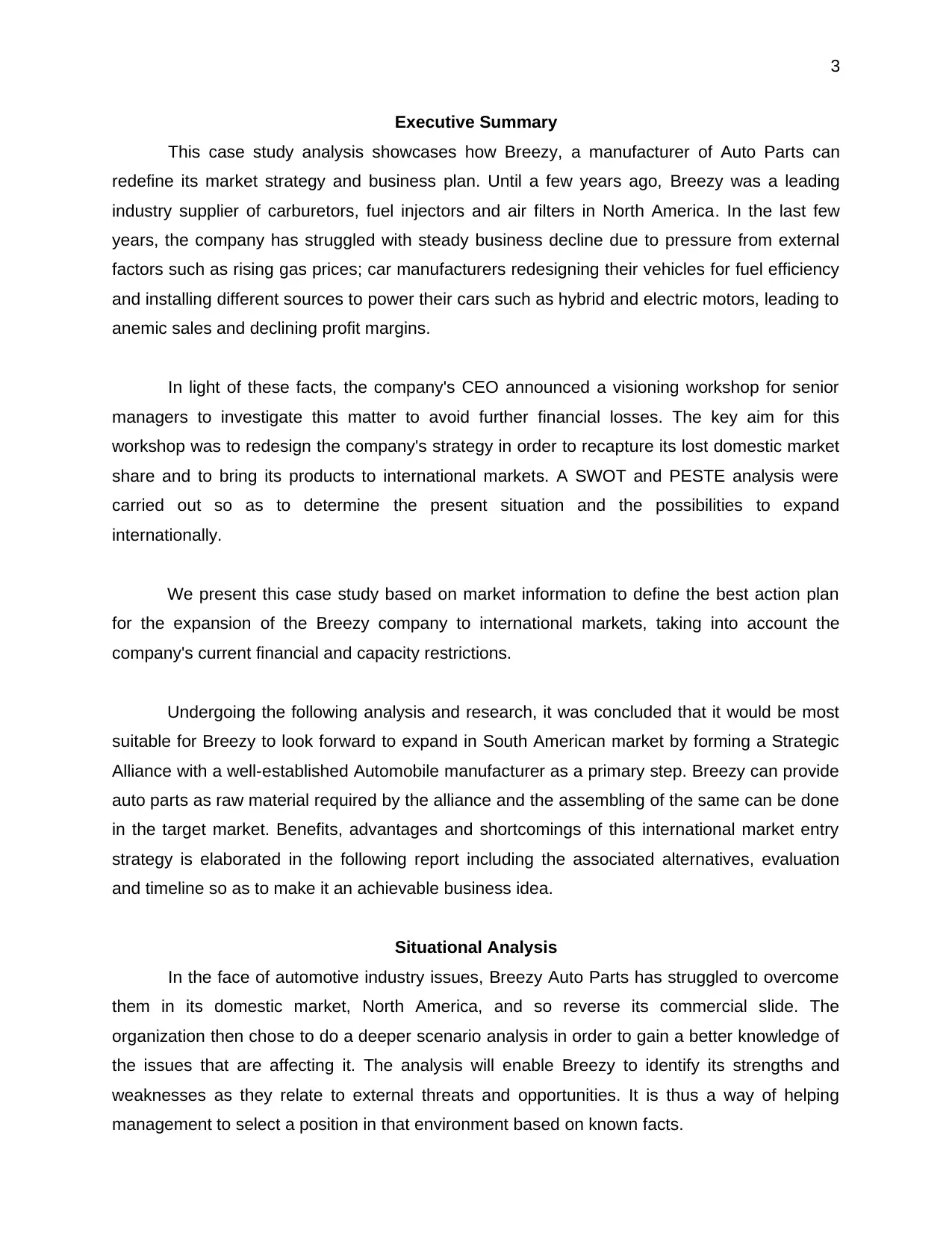
3
Executive Summary
This case study analysis showcases how Breezy, a manufacturer of Auto Parts can
redefine its market strategy and business plan. Until a few years ago, Breezy was a leading
industry supplier of carburetors, fuel injectors and air filters in North America. In the last few
years, the company has struggled with steady business decline due to pressure from external
factors such as rising gas prices; car manufacturers redesigning their vehicles for fuel efficiency
and installing different sources to power their cars such as hybrid and electric motors, leading to
anemic sales and declining profit margins.
In light of these facts, the company's CEO announced a visioning workshop for senior
managers to investigate this matter to avoid further financial losses. The key aim for this
workshop was to redesign the company's strategy in order to recapture its lost domestic market
share and to bring its products to international markets. A SWOT and PESTE analysis were
carried out so as to determine the present situation and the possibilities to expand
internationally.
We present this case study based on market information to define the best action plan
for the expansion of the Breezy company to international markets, taking into account the
company's current financial and capacity restrictions.
Undergoing the following analysis and research, it was concluded that it would be most
suitable for Breezy to look forward to expand in South American market by forming a Strategic
Alliance with a well-established Automobile manufacturer as a primary step. Breezy can provide
auto parts as raw material required by the alliance and the assembling of the same can be done
in the target market. Benefits, advantages and shortcomings of this international market entry
strategy is elaborated in the following report including the associated alternatives, evaluation
and timeline so as to make it an achievable business idea.
Situational Analysis
In the face of automotive industry issues, Breezy Auto Parts has struggled to overcome
them in its domestic market, North America, and so reverse its commercial slide. The
organization then chose to do a deeper scenario analysis in order to gain a better knowledge of
the issues that are affecting it. The analysis will enable Breezy to identify its strengths and
weaknesses as they relate to external threats and opportunities. It is thus a way of helping
management to select a position in that environment based on known facts.
Executive Summary
This case study analysis showcases how Breezy, a manufacturer of Auto Parts can
redefine its market strategy and business plan. Until a few years ago, Breezy was a leading
industry supplier of carburetors, fuel injectors and air filters in North America. In the last few
years, the company has struggled with steady business decline due to pressure from external
factors such as rising gas prices; car manufacturers redesigning their vehicles for fuel efficiency
and installing different sources to power their cars such as hybrid and electric motors, leading to
anemic sales and declining profit margins.
In light of these facts, the company's CEO announced a visioning workshop for senior
managers to investigate this matter to avoid further financial losses. The key aim for this
workshop was to redesign the company's strategy in order to recapture its lost domestic market
share and to bring its products to international markets. A SWOT and PESTE analysis were
carried out so as to determine the present situation and the possibilities to expand
internationally.
We present this case study based on market information to define the best action plan
for the expansion of the Breezy company to international markets, taking into account the
company's current financial and capacity restrictions.
Undergoing the following analysis and research, it was concluded that it would be most
suitable for Breezy to look forward to expand in South American market by forming a Strategic
Alliance with a well-established Automobile manufacturer as a primary step. Breezy can provide
auto parts as raw material required by the alliance and the assembling of the same can be done
in the target market. Benefits, advantages and shortcomings of this international market entry
strategy is elaborated in the following report including the associated alternatives, evaluation
and timeline so as to make it an achievable business idea.
Situational Analysis
In the face of automotive industry issues, Breezy Auto Parts has struggled to overcome
them in its domestic market, North America, and so reverse its commercial slide. The
organization then chose to do a deeper scenario analysis in order to gain a better knowledge of
the issues that are affecting it. The analysis will enable Breezy to identify its strengths and
weaknesses as they relate to external threats and opportunities. It is thus a way of helping
management to select a position in that environment based on known facts.
⊘ This is a preview!⊘
Do you want full access?
Subscribe today to unlock all pages.

Trusted by 1+ million students worldwide
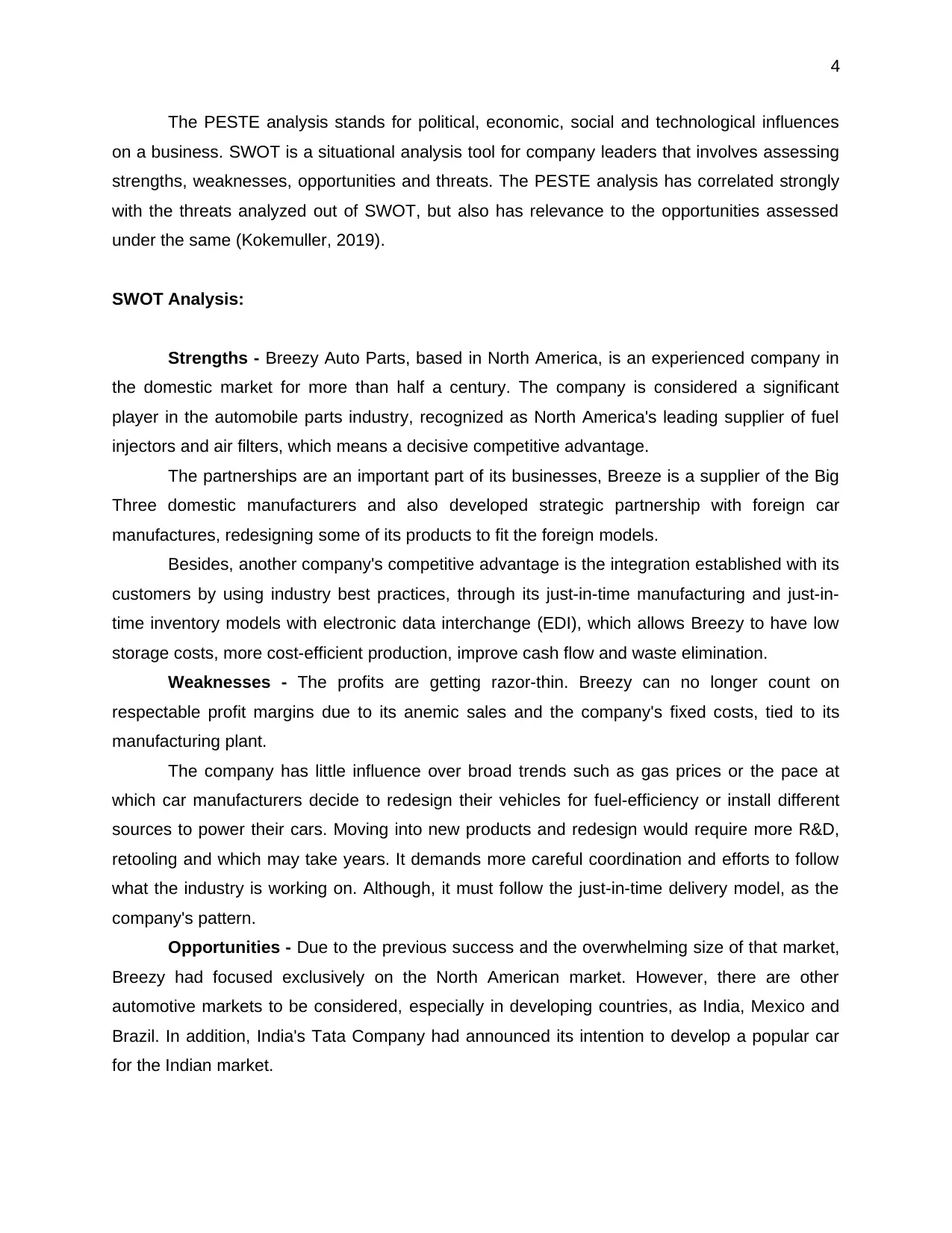
4
The PESTE analysis stands for political, economic, social and technological influences
on a business. SWOT is a situational analysis tool for company leaders that involves assessing
strengths, weaknesses, opportunities and threats. The PESTE analysis has correlated strongly
with the threats analyzed out of SWOT, but also has relevance to the opportunities assessed
under the same (Kokemuller, 2019).
SWOT Analysis:
Strengths - Breezy Auto Parts, based in North America, is an experienced company in
the domestic market for more than half a century. The company is considered a significant
player in the automobile parts industry, recognized as North America's leading supplier of fuel
injectors and air filters, which means a decisive competitive advantage.
The partnerships are an important part of its businesses, Breeze is a supplier of the Big
Three domestic manufacturers and also developed strategic partnership with foreign car
manufactures, redesigning some of its products to fit the foreign models.
Besides, another company's competitive advantage is the integration established with its
customers by using industry best practices, through its just-in-time manufacturing and just-in-
time inventory models with electronic data interchange (EDI), which allows Breezy to have low
storage costs, more cost-efficient production, improve cash flow and waste elimination.
Weaknesses - The profits are getting razor-thin. Breezy can no longer count on
respectable profit margins due to its anemic sales and the company's fixed costs, tied to its
manufacturing plant.
The company has little influence over broad trends such as gas prices or the pace at
which car manufacturers decide to redesign their vehicles for fuel-efficiency or install different
sources to power their cars. Moving into new products and redesign would require more R&D,
retooling and which may take years. It demands more careful coordination and efforts to follow
what the industry is working on. Although, it must follow the just-in-time delivery model, as the
company's pattern.
Opportunities - Due to the previous success and the overwhelming size of that market,
Breezy had focused exclusively on the North American market. However, there are other
automotive markets to be considered, especially in developing countries, as India, Mexico and
Brazil. In addition, India's Tata Company had announced its intention to develop a popular car
for the Indian market.
The PESTE analysis stands for political, economic, social and technological influences
on a business. SWOT is a situational analysis tool for company leaders that involves assessing
strengths, weaknesses, opportunities and threats. The PESTE analysis has correlated strongly
with the threats analyzed out of SWOT, but also has relevance to the opportunities assessed
under the same (Kokemuller, 2019).
SWOT Analysis:
Strengths - Breezy Auto Parts, based in North America, is an experienced company in
the domestic market for more than half a century. The company is considered a significant
player in the automobile parts industry, recognized as North America's leading supplier of fuel
injectors and air filters, which means a decisive competitive advantage.
The partnerships are an important part of its businesses, Breeze is a supplier of the Big
Three domestic manufacturers and also developed strategic partnership with foreign car
manufactures, redesigning some of its products to fit the foreign models.
Besides, another company's competitive advantage is the integration established with its
customers by using industry best practices, through its just-in-time manufacturing and just-in-
time inventory models with electronic data interchange (EDI), which allows Breezy to have low
storage costs, more cost-efficient production, improve cash flow and waste elimination.
Weaknesses - The profits are getting razor-thin. Breezy can no longer count on
respectable profit margins due to its anemic sales and the company's fixed costs, tied to its
manufacturing plant.
The company has little influence over broad trends such as gas prices or the pace at
which car manufacturers decide to redesign their vehicles for fuel-efficiency or install different
sources to power their cars. Moving into new products and redesign would require more R&D,
retooling and which may take years. It demands more careful coordination and efforts to follow
what the industry is working on. Although, it must follow the just-in-time delivery model, as the
company's pattern.
Opportunities - Due to the previous success and the overwhelming size of that market,
Breezy had focused exclusively on the North American market. However, there are other
automotive markets to be considered, especially in developing countries, as India, Mexico and
Brazil. In addition, India's Tata Company had announced its intention to develop a popular car
for the Indian market.
Paraphrase This Document
Need a fresh take? Get an instant paraphrase of this document with our AI Paraphraser
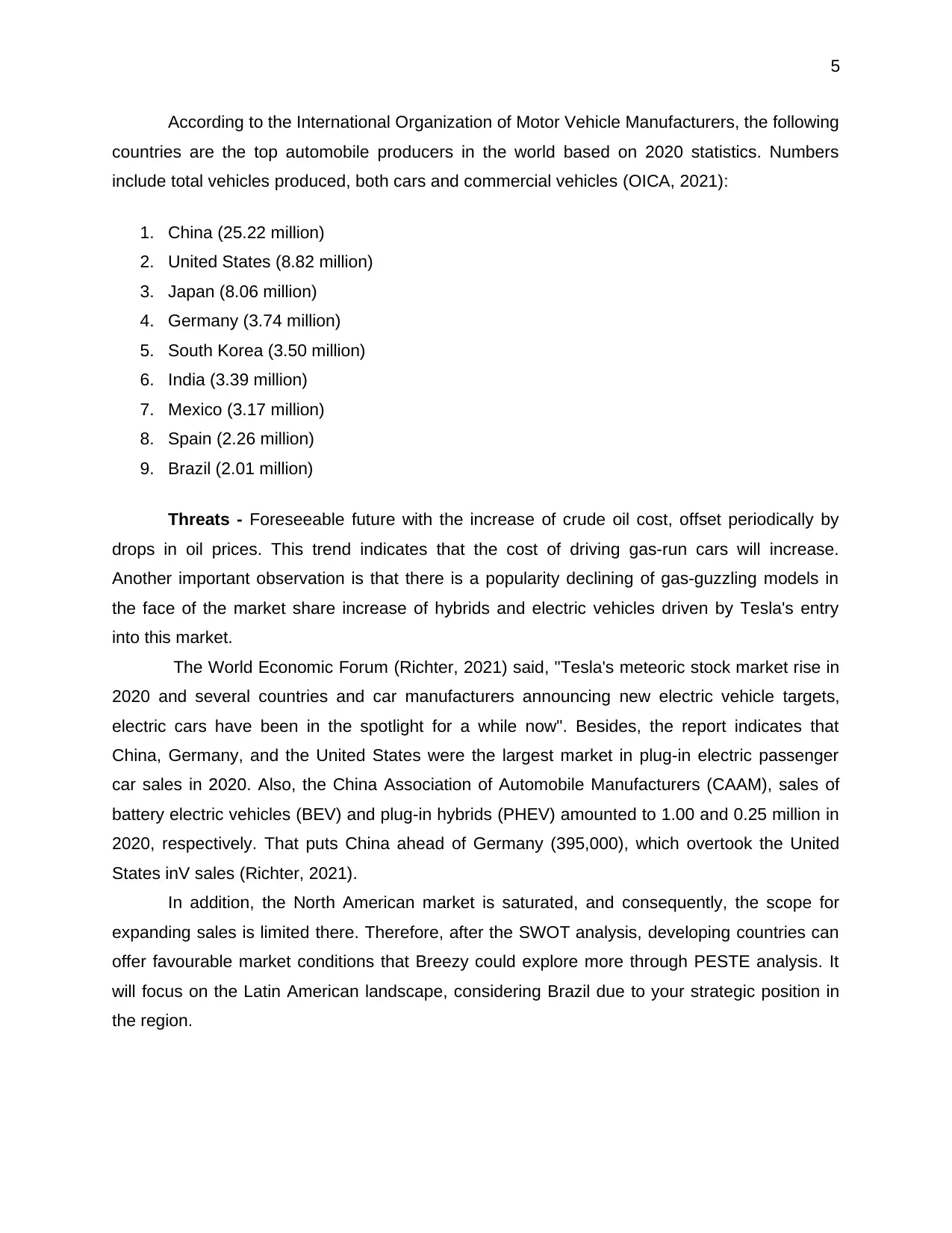
5
According to the International Organization of Motor Vehicle Manufacturers, the following
countries are the top automobile producers in the world based on 2020 statistics. Numbers
include total vehicles produced, both cars and commercial vehicles (OICA, 2021):
1. China (25.22 million)
2. United States (8.82 million)
3. Japan (8.06 million)
4. Germany (3.74 million)
5. South Korea (3.50 million)
6. India (3.39 million)
7. Mexico (3.17 million)
8. Spain (2.26 million)
9. Brazil (2.01 million)
Threats - Foreseeable future with the increase of crude oil cost, offset periodically by
drops in oil prices. This trend indicates that the cost of driving gas-run cars will increase.
Another important observation is that there is a popularity declining of gas-guzzling models in
the face of the market share increase of hybrids and electric vehicles driven by Tesla's entry
into this market.
The World Economic Forum (Richter, 2021) said, "Tesla's meteoric stock market rise in
2020 and several countries and car manufacturers announcing new electric vehicle targets,
electric cars have been in the spotlight for a while now". Besides, the report indicates that
China, Germany, and the United States were the largest market in plug-in electric passenger
car sales in 2020. Also, the China Association of Automobile Manufacturers (CAAM), sales of
battery electric vehicles (BEV) and plug-in hybrids (PHEV) amounted to 1.00 and 0.25 million in
2020, respectively. That puts China ahead of Germany (395,000), which overtook the United
States inV sales (Richter, 2021).
In addition, the North American market is saturated, and consequently, the scope for
expanding sales is limited there. Therefore, after the SWOT analysis, developing countries can
offer favourable market conditions that Breezy could explore more through PESTE analysis. It
will focus on the Latin American landscape, considering Brazil due to your strategic position in
the region.
According to the International Organization of Motor Vehicle Manufacturers, the following
countries are the top automobile producers in the world based on 2020 statistics. Numbers
include total vehicles produced, both cars and commercial vehicles (OICA, 2021):
1. China (25.22 million)
2. United States (8.82 million)
3. Japan (8.06 million)
4. Germany (3.74 million)
5. South Korea (3.50 million)
6. India (3.39 million)
7. Mexico (3.17 million)
8. Spain (2.26 million)
9. Brazil (2.01 million)
Threats - Foreseeable future with the increase of crude oil cost, offset periodically by
drops in oil prices. This trend indicates that the cost of driving gas-run cars will increase.
Another important observation is that there is a popularity declining of gas-guzzling models in
the face of the market share increase of hybrids and electric vehicles driven by Tesla's entry
into this market.
The World Economic Forum (Richter, 2021) said, "Tesla's meteoric stock market rise in
2020 and several countries and car manufacturers announcing new electric vehicle targets,
electric cars have been in the spotlight for a while now". Besides, the report indicates that
China, Germany, and the United States were the largest market in plug-in electric passenger
car sales in 2020. Also, the China Association of Automobile Manufacturers (CAAM), sales of
battery electric vehicles (BEV) and plug-in hybrids (PHEV) amounted to 1.00 and 0.25 million in
2020, respectively. That puts China ahead of Germany (395,000), which overtook the United
States inV sales (Richter, 2021).
In addition, the North American market is saturated, and consequently, the scope for
expanding sales is limited there. Therefore, after the SWOT analysis, developing countries can
offer favourable market conditions that Breezy could explore more through PESTE analysis. It
will focus on the Latin American landscape, considering Brazil due to your strategic position in
the region.
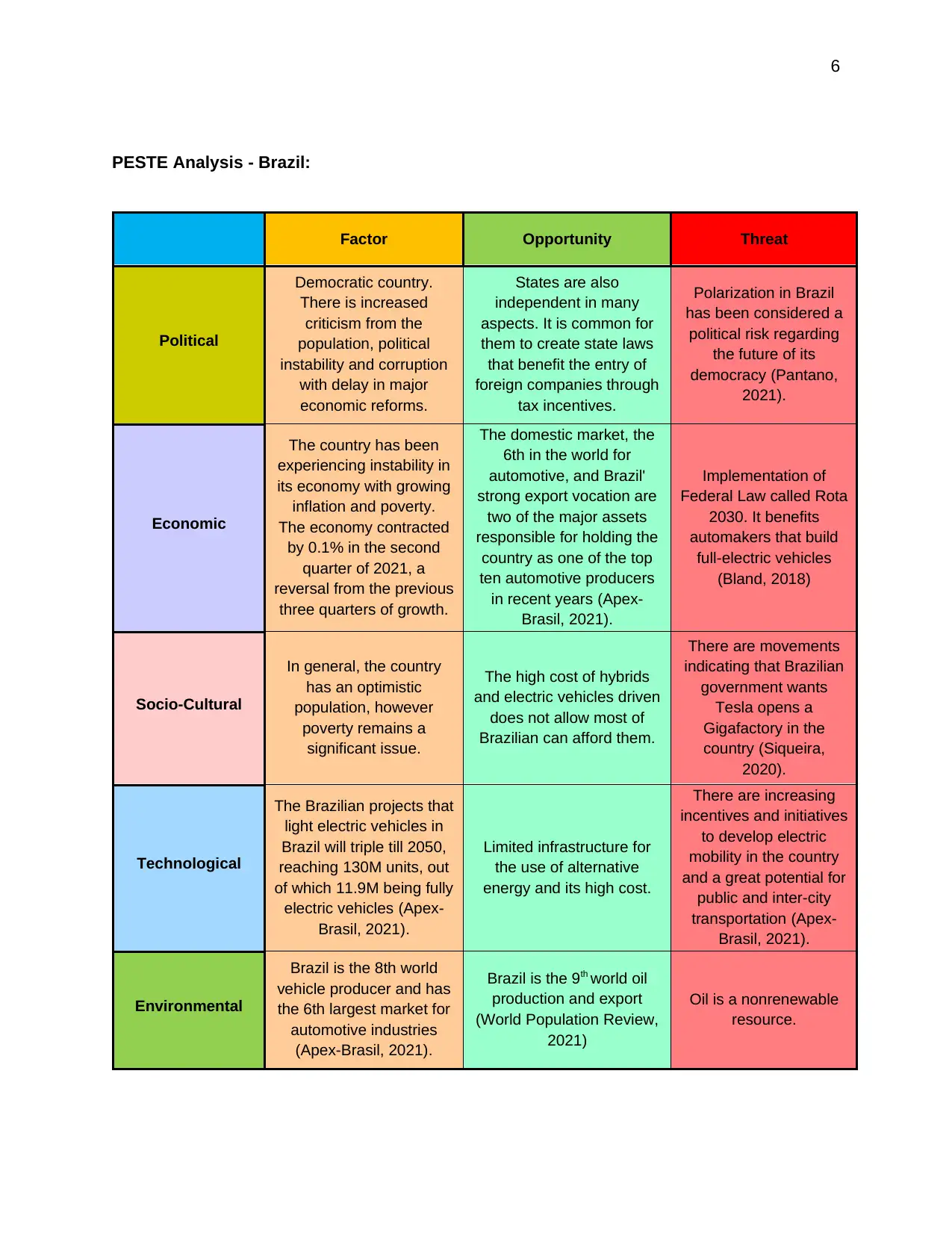
6
PESTE Analysis - Brazil:
Factor Opportunity Threat
Political
Democratic country.
There is increased
criticism from the
population, political
instability and corruption
with delay in major
economic reforms.
States are also
independent in many
aspects. It is common for
them to create state laws
that benefit the entry of
foreign companies through
tax incentives.
Polarization in Brazil
has been considered a
political risk regarding
the future of its
democracy (Pantano,
2021).
Economic
The country has been
experiencing instability in
its economy with growing
inflation and poverty.
The economy contracted
by 0.1% in the second
quarter of 2021, a
reversal from the previous
three quarters of growth.
The domestic market, the
6th in the world for
automotive, and Brazil'
strong export vocation are
two of the major assets
responsible for holding the
country as one of the top
ten automotive producers
in recent years (Apex-
Brasil, 2021).
Implementation of
Federal Law called Rota
2030. It benefits
automakers that build
full-electric vehicles
(Bland, 2018)
Socio-Cultural
In general, the country
has an optimistic
population, however
poverty remains a
significant issue.
The high cost of hybrids
and electric vehicles driven
does not allow most of
Brazilian can afford them.
There are movements
indicating that Brazilian
government wants
Tesla opens a
Gigafactory in the
country (Siqueira,
2020).
Technological
The Brazilian projects that
light electric vehicles in
Brazil will triple till 2050,
reaching 130M units, out
of which 11.9M being fully
electric vehicles (Apex-
Brasil, 2021).
Limited infrastructure for
the use of alternative
energy and its high cost.
There are increasing
incentives and initiatives
to develop electric
mobility in the country
and a great potential for
public and inter-city
transportation (Apex-
Brasil, 2021).
Environmental
Brazil is the 8th world
vehicle producer and has
the 6th largest market for
automotive industries
(Apex-Brasil, 2021).
Brazil is the 9th world oil
production and export
(World Population Review,
2021)
Oil is a nonrenewable
resource.
PESTE Analysis - Brazil:
Factor Opportunity Threat
Political
Democratic country.
There is increased
criticism from the
population, political
instability and corruption
with delay in major
economic reforms.
States are also
independent in many
aspects. It is common for
them to create state laws
that benefit the entry of
foreign companies through
tax incentives.
Polarization in Brazil
has been considered a
political risk regarding
the future of its
democracy (Pantano,
2021).
Economic
The country has been
experiencing instability in
its economy with growing
inflation and poverty.
The economy contracted
by 0.1% in the second
quarter of 2021, a
reversal from the previous
three quarters of growth.
The domestic market, the
6th in the world for
automotive, and Brazil'
strong export vocation are
two of the major assets
responsible for holding the
country as one of the top
ten automotive producers
in recent years (Apex-
Brasil, 2021).
Implementation of
Federal Law called Rota
2030. It benefits
automakers that build
full-electric vehicles
(Bland, 2018)
Socio-Cultural
In general, the country
has an optimistic
population, however
poverty remains a
significant issue.
The high cost of hybrids
and electric vehicles driven
does not allow most of
Brazilian can afford them.
There are movements
indicating that Brazilian
government wants
Tesla opens a
Gigafactory in the
country (Siqueira,
2020).
Technological
The Brazilian projects that
light electric vehicles in
Brazil will triple till 2050,
reaching 130M units, out
of which 11.9M being fully
electric vehicles (Apex-
Brasil, 2021).
Limited infrastructure for
the use of alternative
energy and its high cost.
There are increasing
incentives and initiatives
to develop electric
mobility in the country
and a great potential for
public and inter-city
transportation (Apex-
Brasil, 2021).
Environmental
Brazil is the 8th world
vehicle producer and has
the 6th largest market for
automotive industries
(Apex-Brasil, 2021).
Brazil is the 9th world oil
production and export
(World Population Review,
2021)
Oil is a nonrenewable
resource.
⊘ This is a preview!⊘
Do you want full access?
Subscribe today to unlock all pages.

Trusted by 1+ million students worldwide
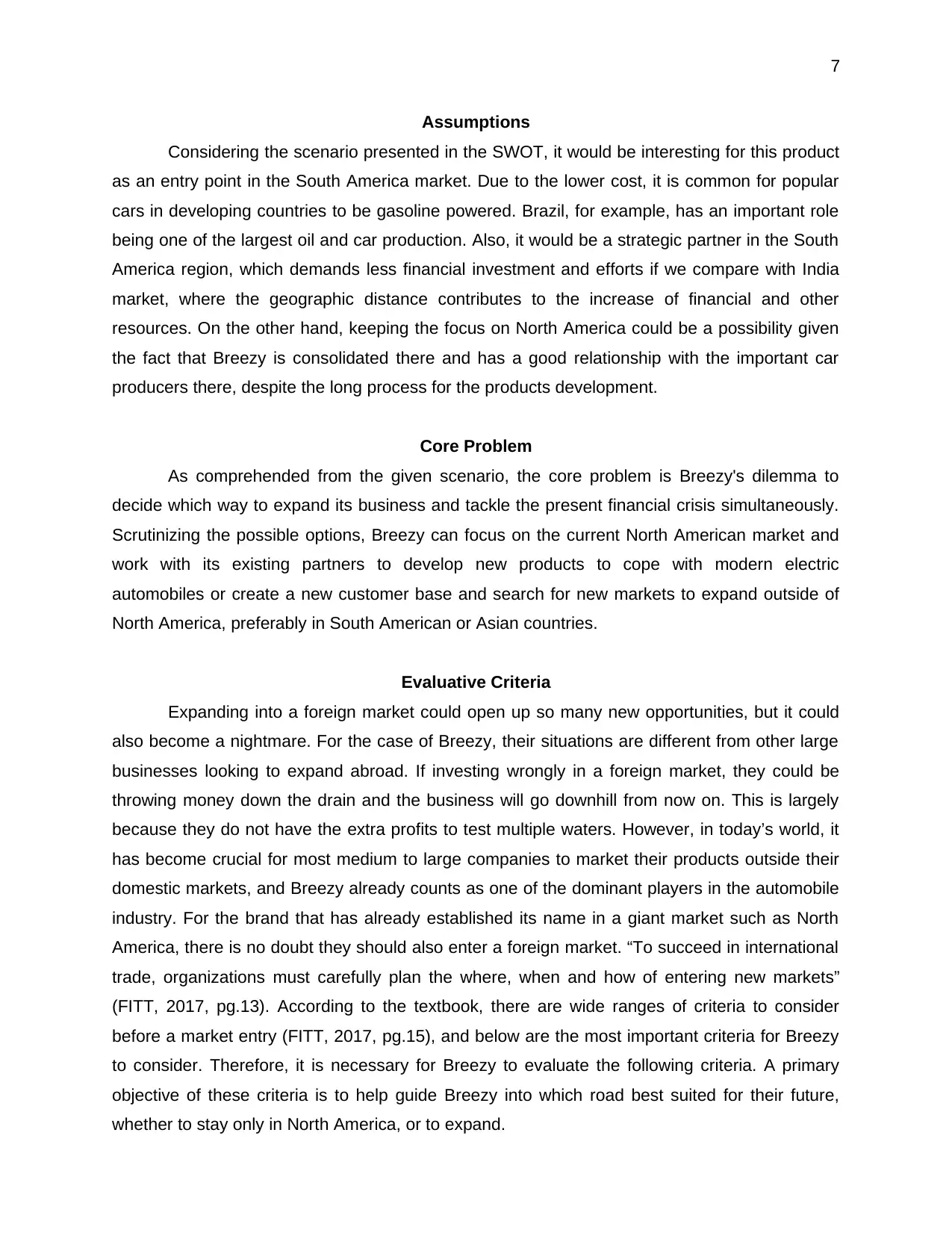
7
Assumptions
Considering the scenario presented in the SWOT, it would be interesting for this product
as an entry point in the South America market. Due to the lower cost, it is common for popular
cars in developing countries to be gasoline powered. Brazil, for example, has an important role
being one of the largest oil and car production. Also, it would be a strategic partner in the South
America region, which demands less financial investment and efforts if we compare with India
market, where the geographic distance contributes to the increase of financial and other
resources. On the other hand, keeping the focus on North America could be a possibility given
the fact that Breezy is consolidated there and has a good relationship with the important car
producers there, despite the long process for the products development.
Core Problem
As comprehended from the given scenario, the core problem is Breezy's dilemma to
decide which way to expand its business and tackle the present financial crisis simultaneously.
Scrutinizing the possible options, Breezy can focus on the current North American market and
work with its existing partners to develop new products to cope with modern electric
automobiles or create a new customer base and search for new markets to expand outside of
North America, preferably in South American or Asian countries.
Evaluative Criteria
Expanding into a foreign market could open up so many new opportunities, but it could
also become a nightmare. For the case of Breezy, their situations are different from other large
businesses looking to expand abroad. If investing wrongly in a foreign market, they could be
throwing money down the drain and the business will go downhill from now on. This is largely
because they do not have the extra profits to test multiple waters. However, in today’s world, it
has become crucial for most medium to large companies to market their products outside their
domestic markets, and Breezy already counts as one of the dominant players in the automobile
industry. For the brand that has already established its name in a giant market such as North
America, there is no doubt they should also enter a foreign market. “To succeed in international
trade, organizations must carefully plan the where, when and how of entering new markets”
(FITT, 2017, pg.13). According to the textbook, there are wide ranges of criteria to consider
before a market entry (FITT, 2017, pg.15), and below are the most important criteria for Breezy
to consider. Therefore, it is necessary for Breezy to evaluate the following criteria. A primary
objective of these criteria is to help guide Breezy into which road best suited for their future,
whether to stay only in North America, or to expand.
Assumptions
Considering the scenario presented in the SWOT, it would be interesting for this product
as an entry point in the South America market. Due to the lower cost, it is common for popular
cars in developing countries to be gasoline powered. Brazil, for example, has an important role
being one of the largest oil and car production. Also, it would be a strategic partner in the South
America region, which demands less financial investment and efforts if we compare with India
market, where the geographic distance contributes to the increase of financial and other
resources. On the other hand, keeping the focus on North America could be a possibility given
the fact that Breezy is consolidated there and has a good relationship with the important car
producers there, despite the long process for the products development.
Core Problem
As comprehended from the given scenario, the core problem is Breezy's dilemma to
decide which way to expand its business and tackle the present financial crisis simultaneously.
Scrutinizing the possible options, Breezy can focus on the current North American market and
work with its existing partners to develop new products to cope with modern electric
automobiles or create a new customer base and search for new markets to expand outside of
North America, preferably in South American or Asian countries.
Evaluative Criteria
Expanding into a foreign market could open up so many new opportunities, but it could
also become a nightmare. For the case of Breezy, their situations are different from other large
businesses looking to expand abroad. If investing wrongly in a foreign market, they could be
throwing money down the drain and the business will go downhill from now on. This is largely
because they do not have the extra profits to test multiple waters. However, in today’s world, it
has become crucial for most medium to large companies to market their products outside their
domestic markets, and Breezy already counts as one of the dominant players in the automobile
industry. For the brand that has already established its name in a giant market such as North
America, there is no doubt they should also enter a foreign market. “To succeed in international
trade, organizations must carefully plan the where, when and how of entering new markets”
(FITT, 2017, pg.13). According to the textbook, there are wide ranges of criteria to consider
before a market entry (FITT, 2017, pg.15), and below are the most important criteria for Breezy
to consider. Therefore, it is necessary for Breezy to evaluate the following criteria. A primary
objective of these criteria is to help guide Breezy into which road best suited for their future,
whether to stay only in North America, or to expand.
Paraphrase This Document
Need a fresh take? Get an instant paraphrase of this document with our AI Paraphraser
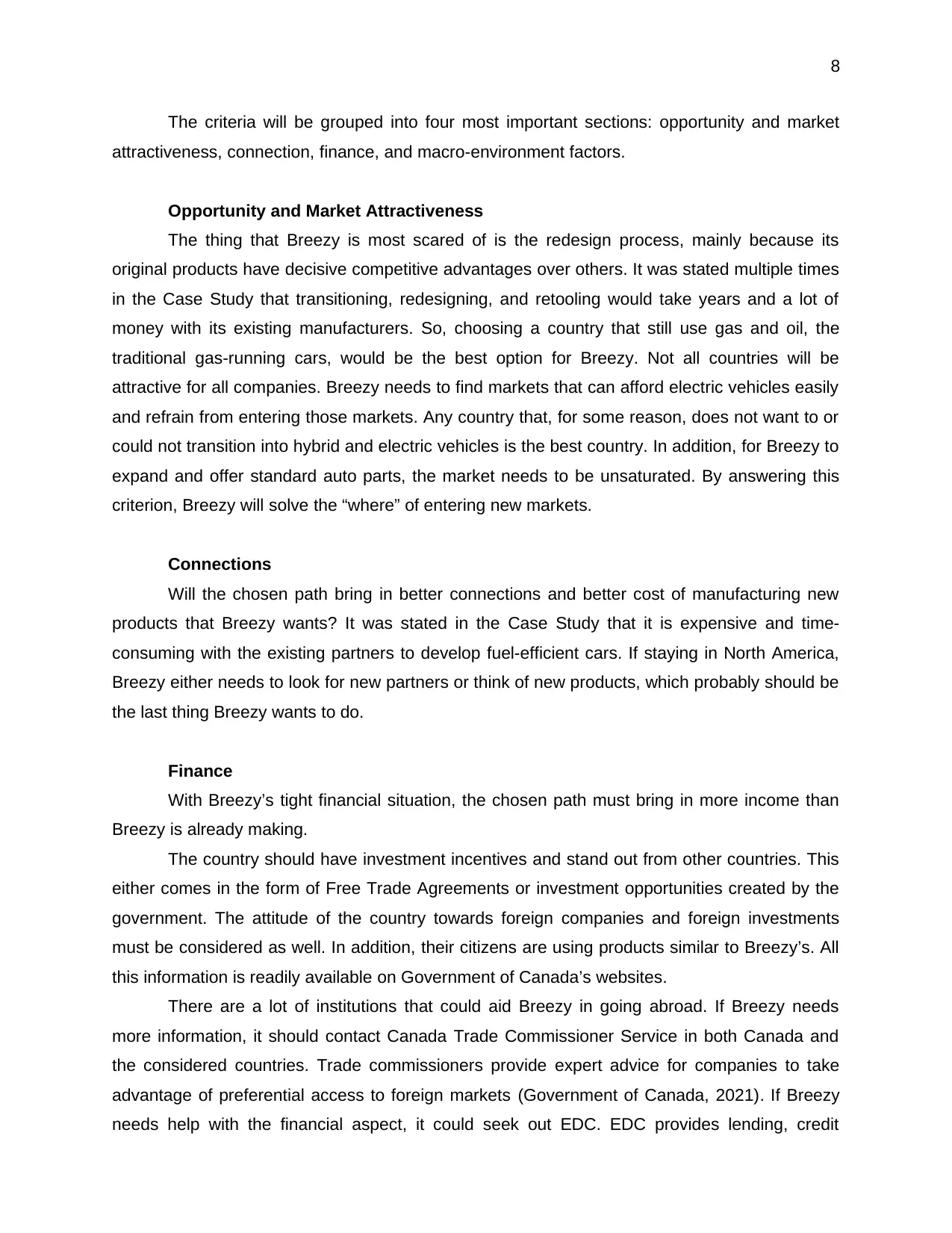
8
The criteria will be grouped into four most important sections: opportunity and market
attractiveness, connection, finance, and macro-environment factors.
Opportunity and Market Attractiveness
The thing that Breezy is most scared of is the redesign process, mainly because its
original products have decisive competitive advantages over others. It was stated multiple times
in the Case Study that transitioning, redesigning, and retooling would take years and a lot of
money with its existing manufacturers. So, choosing a country that still use gas and oil, the
traditional gas-running cars, would be the best option for Breezy. Not all countries will be
attractive for all companies. Breezy needs to find markets that can afford electric vehicles easily
and refrain from entering those markets. Any country that, for some reason, does not want to or
could not transition into hybrid and electric vehicles is the best country. In addition, for Breezy to
expand and offer standard auto parts, the market needs to be unsaturated. By answering this
criterion, Breezy will solve the “where” of entering new markets.
Connections
Will the chosen path bring in better connections and better cost of manufacturing new
products that Breezy wants? It was stated in the Case Study that it is expensive and time-
consuming with the existing partners to develop fuel-efficient cars. If staying in North America,
Breezy either needs to look for new partners or think of new products, which probably should be
the last thing Breezy wants to do.
Finance
With Breezy’s tight financial situation, the chosen path must bring in more income than
Breezy is already making.
The country should have investment incentives and stand out from other countries. This
either comes in the form of Free Trade Agreements or investment opportunities created by the
government. The attitude of the country towards foreign companies and foreign investments
must be considered as well. In addition, their citizens are using products similar to Breezy’s. All
this information is readily available on Government of Canada’s websites.
There are a lot of institutions that could aid Breezy in going abroad. If Breezy needs
more information, it should contact Canada Trade Commissioner Service in both Canada and
the considered countries. Trade commissioners provide expert advice for companies to take
advantage of preferential access to foreign markets (Government of Canada, 2021). If Breezy
needs help with the financial aspect, it could seek out EDC. EDC provides lending, credit
The criteria will be grouped into four most important sections: opportunity and market
attractiveness, connection, finance, and macro-environment factors.
Opportunity and Market Attractiveness
The thing that Breezy is most scared of is the redesign process, mainly because its
original products have decisive competitive advantages over others. It was stated multiple times
in the Case Study that transitioning, redesigning, and retooling would take years and a lot of
money with its existing manufacturers. So, choosing a country that still use gas and oil, the
traditional gas-running cars, would be the best option for Breezy. Not all countries will be
attractive for all companies. Breezy needs to find markets that can afford electric vehicles easily
and refrain from entering those markets. Any country that, for some reason, does not want to or
could not transition into hybrid and electric vehicles is the best country. In addition, for Breezy to
expand and offer standard auto parts, the market needs to be unsaturated. By answering this
criterion, Breezy will solve the “where” of entering new markets.
Connections
Will the chosen path bring in better connections and better cost of manufacturing new
products that Breezy wants? It was stated in the Case Study that it is expensive and time-
consuming with the existing partners to develop fuel-efficient cars. If staying in North America,
Breezy either needs to look for new partners or think of new products, which probably should be
the last thing Breezy wants to do.
Finance
With Breezy’s tight financial situation, the chosen path must bring in more income than
Breezy is already making.
The country should have investment incentives and stand out from other countries. This
either comes in the form of Free Trade Agreements or investment opportunities created by the
government. The attitude of the country towards foreign companies and foreign investments
must be considered as well. In addition, their citizens are using products similar to Breezy’s. All
this information is readily available on Government of Canada’s websites.
There are a lot of institutions that could aid Breezy in going abroad. If Breezy needs
more information, it should contact Canada Trade Commissioner Service in both Canada and
the considered countries. Trade commissioners provide expert advice for companies to take
advantage of preferential access to foreign markets (Government of Canada, 2021). If Breezy
needs help with the financial aspect, it could seek out EDC. EDC provides lending, credit
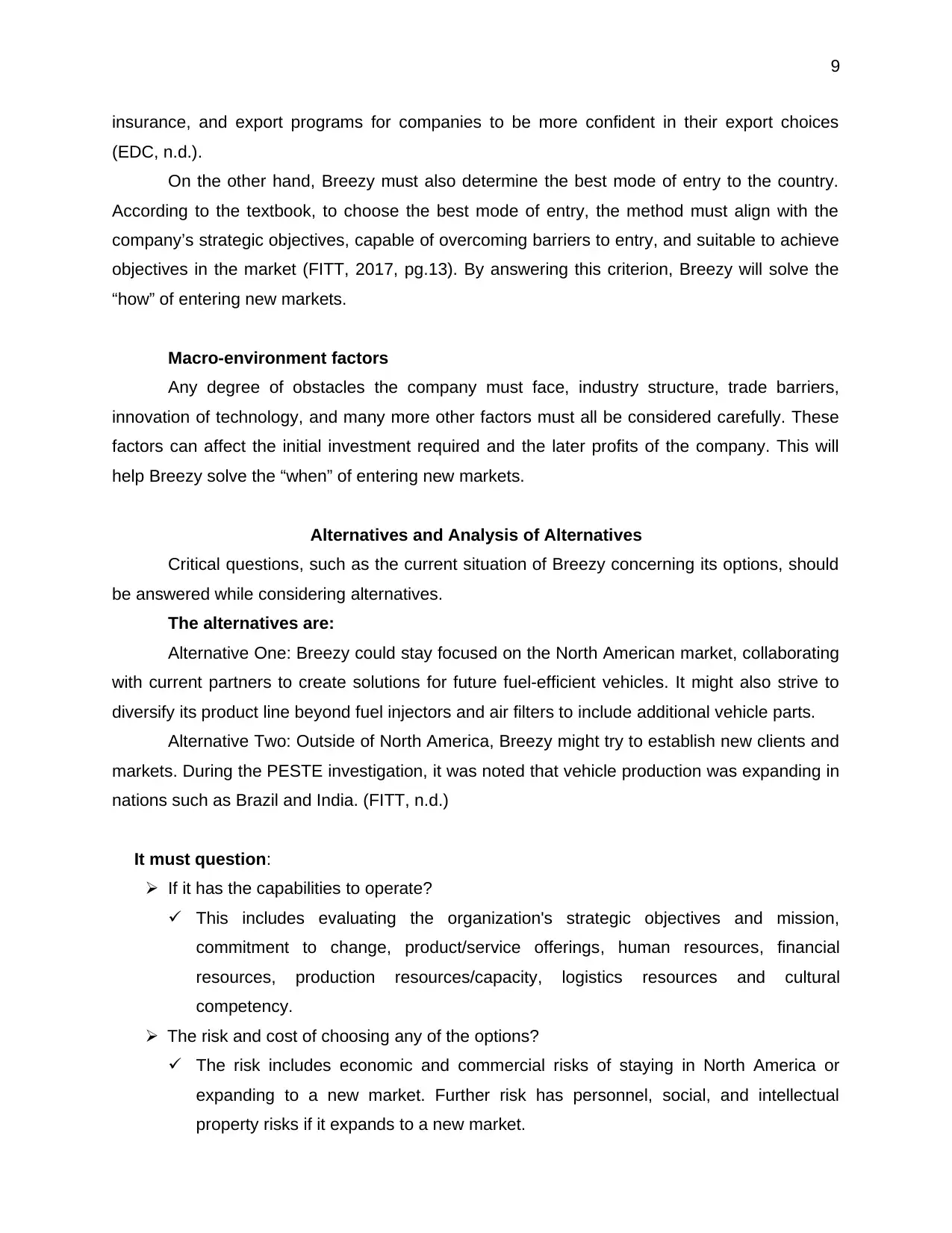
9
insurance, and export programs for companies to be more confident in their export choices
(EDC, n.d.).
On the other hand, Breezy must also determine the best mode of entry to the country.
According to the textbook, to choose the best mode of entry, the method must align with the
company’s strategic objectives, capable of overcoming barriers to entry, and suitable to achieve
objectives in the market (FITT, 2017, pg.13). By answering this criterion, Breezy will solve the
“how” of entering new markets.
Macro-environment factors
Any degree of obstacles the company must face, industry structure, trade barriers,
innovation of technology, and many more other factors must all be considered carefully. These
factors can affect the initial investment required and the later profits of the company. This will
help Breezy solve the “when” of entering new markets.
Alternatives and Analysis of Alternatives
Critical questions, such as the current situation of Breezy concerning its options, should
be answered while considering alternatives.
The alternatives are:
Alternative One: Breezy could stay focused on the North American market, collaborating
with current partners to create solutions for future fuel-efficient vehicles. It might also strive to
diversify its product line beyond fuel injectors and air filters to include additional vehicle parts.
Alternative Two: Outside of North America, Breezy might try to establish new clients and
markets. During the PESTE investigation, it was noted that vehicle production was expanding in
nations such as Brazil and India. (FITT, n.d.)
It must question:
If it has the capabilities to operate?
This includes evaluating the organization's strategic objectives and mission,
commitment to change, product/service offerings, human resources, financial
resources, production resources/capacity, logistics resources and cultural
competency.
The risk and cost of choosing any of the options?
The risk includes economic and commercial risks of staying in North America or
expanding to a new market. Further risk has personnel, social, and intellectual
property risks if it expands to a new market.
insurance, and export programs for companies to be more confident in their export choices
(EDC, n.d.).
On the other hand, Breezy must also determine the best mode of entry to the country.
According to the textbook, to choose the best mode of entry, the method must align with the
company’s strategic objectives, capable of overcoming barriers to entry, and suitable to achieve
objectives in the market (FITT, 2017, pg.13). By answering this criterion, Breezy will solve the
“how” of entering new markets.
Macro-environment factors
Any degree of obstacles the company must face, industry structure, trade barriers,
innovation of technology, and many more other factors must all be considered carefully. These
factors can affect the initial investment required and the later profits of the company. This will
help Breezy solve the “when” of entering new markets.
Alternatives and Analysis of Alternatives
Critical questions, such as the current situation of Breezy concerning its options, should
be answered while considering alternatives.
The alternatives are:
Alternative One: Breezy could stay focused on the North American market, collaborating
with current partners to create solutions for future fuel-efficient vehicles. It might also strive to
diversify its product line beyond fuel injectors and air filters to include additional vehicle parts.
Alternative Two: Outside of North America, Breezy might try to establish new clients and
markets. During the PESTE investigation, it was noted that vehicle production was expanding in
nations such as Brazil and India. (FITT, n.d.)
It must question:
If it has the capabilities to operate?
This includes evaluating the organization's strategic objectives and mission,
commitment to change, product/service offerings, human resources, financial
resources, production resources/capacity, logistics resources and cultural
competency.
The risk and cost of choosing any of the options?
The risk includes economic and commercial risks of staying in North America or
expanding to a new market. Further risk has personnel, social, and intellectual
property risks if it expands to a new market.
⊘ This is a preview!⊘
Do you want full access?
Subscribe today to unlock all pages.

Trusted by 1+ million students worldwide
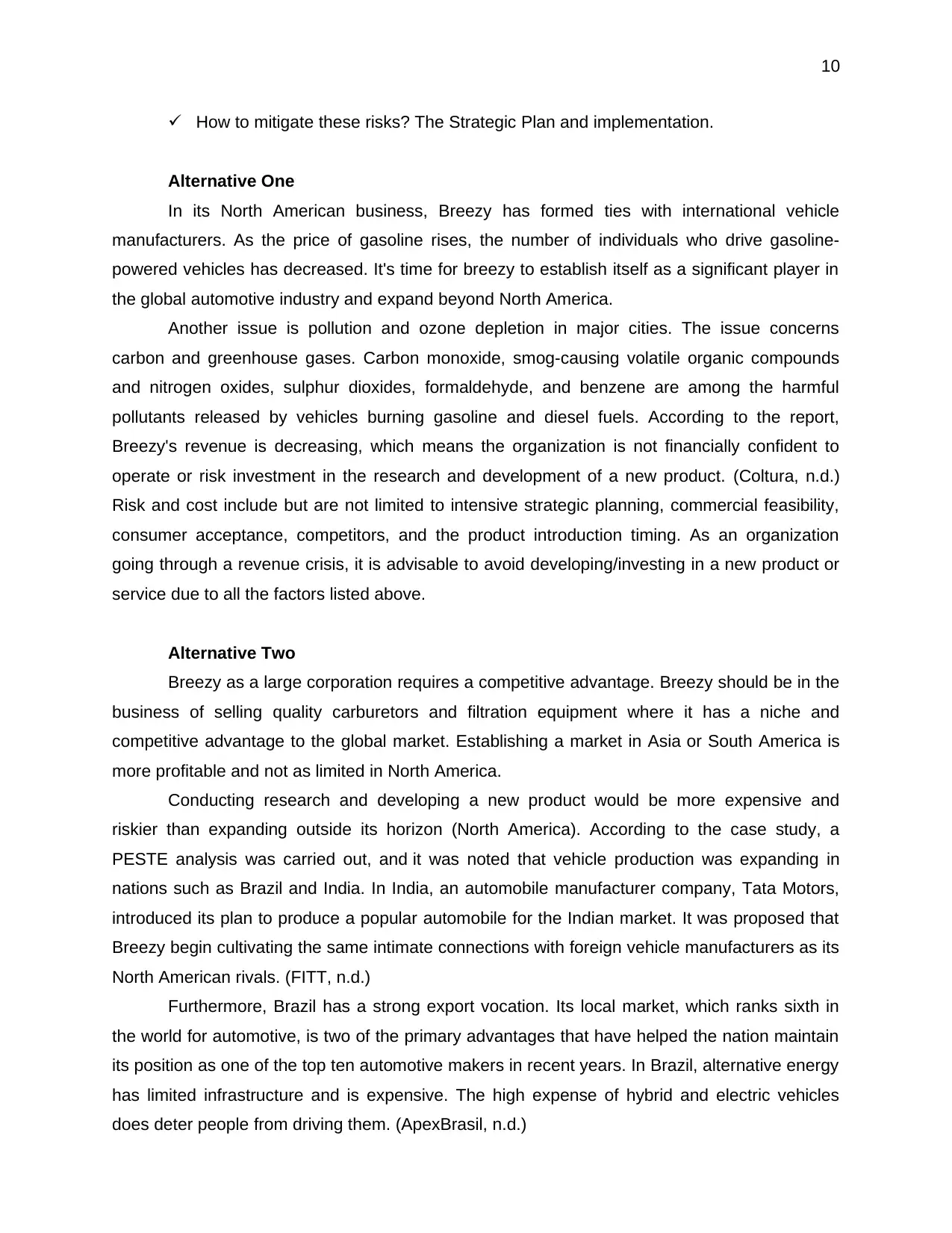
10
How to mitigate these risks? The Strategic Plan and implementation.
Alternative One
In its North American business, Breezy has formed ties with international vehicle
manufacturers. As the price of gasoline rises, the number of individuals who drive gasoline-
powered vehicles has decreased. It's time for breezy to establish itself as a significant player in
the global automotive industry and expand beyond North America.
Another issue is pollution and ozone depletion in major cities. The issue concerns
carbon and greenhouse gases. Carbon monoxide, smog-causing volatile organic compounds
and nitrogen oxides, sulphur dioxides, formaldehyde, and benzene are among the harmful
pollutants released by vehicles burning gasoline and diesel fuels. According to the report,
Breezy's revenue is decreasing, which means the organization is not financially confident to
operate or risk investment in the research and development of a new product. (Coltura, n.d.)
Risk and cost include but are not limited to intensive strategic planning, commercial feasibility,
consumer acceptance, competitors, and the product introduction timing. As an organization
going through a revenue crisis, it is advisable to avoid developing/investing in a new product or
service due to all the factors listed above.
Alternative Two
Breezy as a large corporation requires a competitive advantage. Breezy should be in the
business of selling quality carburetors and filtration equipment where it has a niche and
competitive advantage to the global market. Establishing a market in Asia or South America is
more profitable and not as limited in North America.
Conducting research and developing a new product would be more expensive and
riskier than expanding outside its horizon (North America). According to the case study, a
PESTE analysis was carried out, and it was noted that vehicle production was expanding in
nations such as Brazil and India. In India, an automobile manufacturer company, Tata Motors,
introduced its plan to produce a popular automobile for the Indian market. It was proposed that
Breezy begin cultivating the same intimate connections with foreign vehicle manufacturers as its
North American rivals. (FITT, n.d.)
Furthermore, Brazil has a strong export vocation. Its local market, which ranks sixth in
the world for automotive, is two of the primary advantages that have helped the nation maintain
its position as one of the top ten automotive makers in recent years. In Brazil, alternative energy
has limited infrastructure and is expensive. The high expense of hybrid and electric vehicles
does deter people from driving them. (ApexBrasil, n.d.)
How to mitigate these risks? The Strategic Plan and implementation.
Alternative One
In its North American business, Breezy has formed ties with international vehicle
manufacturers. As the price of gasoline rises, the number of individuals who drive gasoline-
powered vehicles has decreased. It's time for breezy to establish itself as a significant player in
the global automotive industry and expand beyond North America.
Another issue is pollution and ozone depletion in major cities. The issue concerns
carbon and greenhouse gases. Carbon monoxide, smog-causing volatile organic compounds
and nitrogen oxides, sulphur dioxides, formaldehyde, and benzene are among the harmful
pollutants released by vehicles burning gasoline and diesel fuels. According to the report,
Breezy's revenue is decreasing, which means the organization is not financially confident to
operate or risk investment in the research and development of a new product. (Coltura, n.d.)
Risk and cost include but are not limited to intensive strategic planning, commercial feasibility,
consumer acceptance, competitors, and the product introduction timing. As an organization
going through a revenue crisis, it is advisable to avoid developing/investing in a new product or
service due to all the factors listed above.
Alternative Two
Breezy as a large corporation requires a competitive advantage. Breezy should be in the
business of selling quality carburetors and filtration equipment where it has a niche and
competitive advantage to the global market. Establishing a market in Asia or South America is
more profitable and not as limited in North America.
Conducting research and developing a new product would be more expensive and
riskier than expanding outside its horizon (North America). According to the case study, a
PESTE analysis was carried out, and it was noted that vehicle production was expanding in
nations such as Brazil and India. In India, an automobile manufacturer company, Tata Motors,
introduced its plan to produce a popular automobile for the Indian market. It was proposed that
Breezy begin cultivating the same intimate connections with foreign vehicle manufacturers as its
North American rivals. (FITT, n.d.)
Furthermore, Brazil has a strong export vocation. Its local market, which ranks sixth in
the world for automotive, is two of the primary advantages that have helped the nation maintain
its position as one of the top ten automotive makers in recent years. In Brazil, alternative energy
has limited infrastructure and is expensive. The high expense of hybrid and electric vehicles
does deter people from driving them. (ApexBrasil, n.d.)
Paraphrase This Document
Need a fresh take? Get an instant paraphrase of this document with our AI Paraphraser
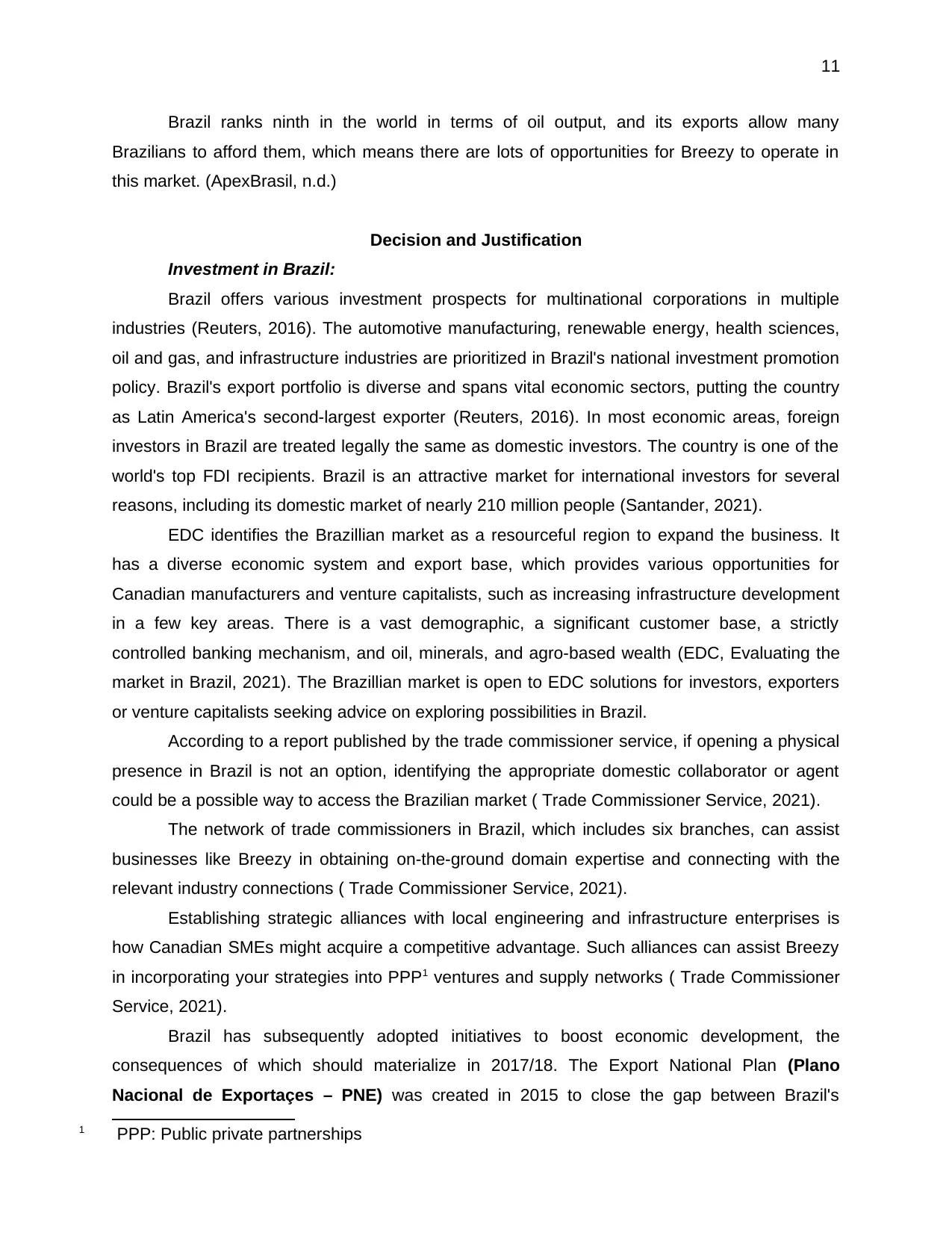
11
Brazil ranks ninth in the world in terms of oil output, and its exports allow many
Brazilians to afford them, which means there are lots of opportunities for Breezy to operate in
this market. (ApexBrasil, n.d.)
Decision and Justification
Investment in Brazil:
Brazil offers various investment prospects for multinational corporations in multiple
industries (Reuters, 2016). The automotive manufacturing, renewable energy, health sciences,
oil and gas, and infrastructure industries are prioritized in Brazil's national investment promotion
policy. Brazil's export portfolio is diverse and spans vital economic sectors, putting the country
as Latin America's second-largest exporter (Reuters, 2016). In most economic areas, foreign
investors in Brazil are treated legally the same as domestic investors. The country is one of the
world's top FDI recipients. Brazil is an attractive market for international investors for several
reasons, including its domestic market of nearly 210 million people (Santander, 2021).
EDC identifies the Brazillian market as a resourceful region to expand the business. It
has a diverse economic system and export base, which provides various opportunities for
Canadian manufacturers and venture capitalists, such as increasing infrastructure development
in a few key areas. There is a vast demographic, a significant customer base, a strictly
controlled banking mechanism, and oil, minerals, and agro-based wealth (EDC, Evaluating the
market in Brazil, 2021). The Brazillian market is open to EDC solutions for investors, exporters
or venture capitalists seeking advice on exploring possibilities in Brazil.
According to a report published by the trade commissioner service, if opening a physical
presence in Brazil is not an option, identifying the appropriate domestic collaborator or agent
could be a possible way to access the Brazilian market ( Trade Commissioner Service, 2021).
The network of trade commissioners in Brazil, which includes six branches, can assist
businesses like Breezy in obtaining on-the-ground domain expertise and connecting with the
relevant industry connections ( Trade Commissioner Service, 2021).
Establishing strategic alliances with local engineering and infrastructure enterprises is
how Canadian SMEs might acquire a competitive advantage. Such alliances can assist Breezy
in incorporating your strategies into PPP1 ventures and supply networks ( Trade Commissioner
Service, 2021).
Brazil has subsequently adopted initiatives to boost economic development, the
consequences of which should materialize in 2017/18. The Export National Plan (Plano
Nacional de Exportaçes – PNE) was created in 2015 to close the gap between Brazil's
1 PPP: Public private partnerships
Brazil ranks ninth in the world in terms of oil output, and its exports allow many
Brazilians to afford them, which means there are lots of opportunities for Breezy to operate in
this market. (ApexBrasil, n.d.)
Decision and Justification
Investment in Brazil:
Brazil offers various investment prospects for multinational corporations in multiple
industries (Reuters, 2016). The automotive manufacturing, renewable energy, health sciences,
oil and gas, and infrastructure industries are prioritized in Brazil's national investment promotion
policy. Brazil's export portfolio is diverse and spans vital economic sectors, putting the country
as Latin America's second-largest exporter (Reuters, 2016). In most economic areas, foreign
investors in Brazil are treated legally the same as domestic investors. The country is one of the
world's top FDI recipients. Brazil is an attractive market for international investors for several
reasons, including its domestic market of nearly 210 million people (Santander, 2021).
EDC identifies the Brazillian market as a resourceful region to expand the business. It
has a diverse economic system and export base, which provides various opportunities for
Canadian manufacturers and venture capitalists, such as increasing infrastructure development
in a few key areas. There is a vast demographic, a significant customer base, a strictly
controlled banking mechanism, and oil, minerals, and agro-based wealth (EDC, Evaluating the
market in Brazil, 2021). The Brazillian market is open to EDC solutions for investors, exporters
or venture capitalists seeking advice on exploring possibilities in Brazil.
According to a report published by the trade commissioner service, if opening a physical
presence in Brazil is not an option, identifying the appropriate domestic collaborator or agent
could be a possible way to access the Brazilian market ( Trade Commissioner Service, 2021).
The network of trade commissioners in Brazil, which includes six branches, can assist
businesses like Breezy in obtaining on-the-ground domain expertise and connecting with the
relevant industry connections ( Trade Commissioner Service, 2021).
Establishing strategic alliances with local engineering and infrastructure enterprises is
how Canadian SMEs might acquire a competitive advantage. Such alliances can assist Breezy
in incorporating your strategies into PPP1 ventures and supply networks ( Trade Commissioner
Service, 2021).
Brazil has subsequently adopted initiatives to boost economic development, the
consequences of which should materialize in 2017/18. The Export National Plan (Plano
Nacional de Exportaçes – PNE) was created in 2015 to close the gap between Brazil's
1 PPP: Public private partnerships
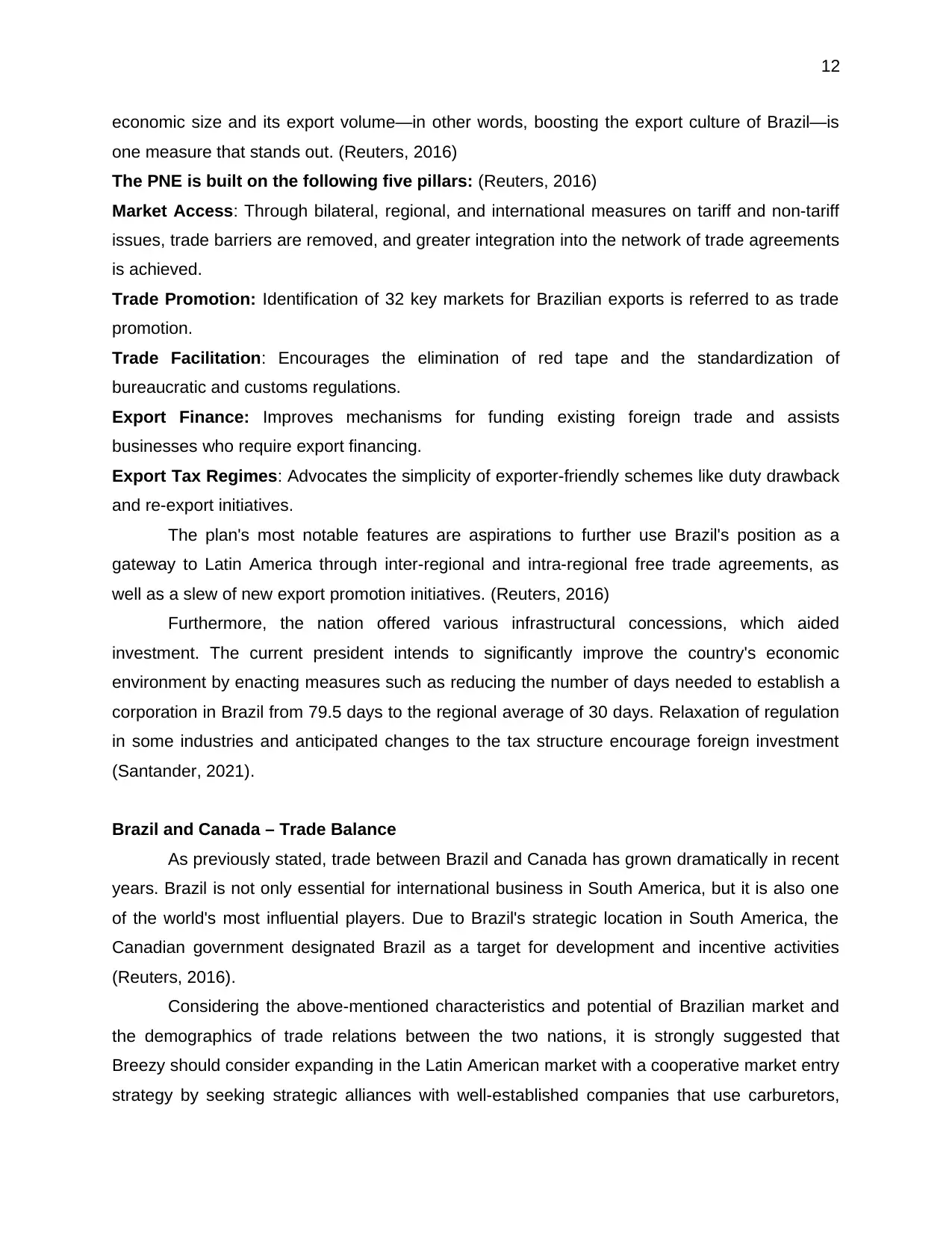
12
economic size and its export volume—in other words, boosting the export culture of Brazil—is
one measure that stands out. (Reuters, 2016)
The PNE is built on the following five pillars: (Reuters, 2016)
Market Access: Through bilateral, regional, and international measures on tariff and non-tariff
issues, trade barriers are removed, and greater integration into the network of trade agreements
is achieved.
Trade Promotion: Identification of 32 key markets for Brazilian exports is referred to as trade
promotion.
Trade Facilitation: Encourages the elimination of red tape and the standardization of
bureaucratic and customs regulations.
Export Finance: Improves mechanisms for funding existing foreign trade and assists
businesses who require export financing.
Export Tax Regimes: Advocates the simplicity of exporter-friendly schemes like duty drawback
and re-export initiatives.
The plan's most notable features are aspirations to further use Brazil's position as a
gateway to Latin America through inter-regional and intra-regional free trade agreements, as
well as a slew of new export promotion initiatives. (Reuters, 2016)
Furthermore, the nation offered various infrastructural concessions, which aided
investment. The current president intends to significantly improve the country's economic
environment by enacting measures such as reducing the number of days needed to establish a
corporation in Brazil from 79.5 days to the regional average of 30 days. Relaxation of regulation
in some industries and anticipated changes to the tax structure encourage foreign investment
(Santander, 2021).
Brazil and Canada – Trade Balance
As previously stated, trade between Brazil and Canada has grown dramatically in recent
years. Brazil is not only essential for international business in South America, but it is also one
of the world's most influential players. Due to Brazil's strategic location in South America, the
Canadian government designated Brazil as a target for development and incentive activities
(Reuters, 2016).
Considering the above-mentioned characteristics and potential of Brazilian market and
the demographics of trade relations between the two nations, it is strongly suggested that
Breezy should consider expanding in the Latin American market with a cooperative market entry
strategy by seeking strategic alliances with well-established companies that use carburetors,
economic size and its export volume—in other words, boosting the export culture of Brazil—is
one measure that stands out. (Reuters, 2016)
The PNE is built on the following five pillars: (Reuters, 2016)
Market Access: Through bilateral, regional, and international measures on tariff and non-tariff
issues, trade barriers are removed, and greater integration into the network of trade agreements
is achieved.
Trade Promotion: Identification of 32 key markets for Brazilian exports is referred to as trade
promotion.
Trade Facilitation: Encourages the elimination of red tape and the standardization of
bureaucratic and customs regulations.
Export Finance: Improves mechanisms for funding existing foreign trade and assists
businesses who require export financing.
Export Tax Regimes: Advocates the simplicity of exporter-friendly schemes like duty drawback
and re-export initiatives.
The plan's most notable features are aspirations to further use Brazil's position as a
gateway to Latin America through inter-regional and intra-regional free trade agreements, as
well as a slew of new export promotion initiatives. (Reuters, 2016)
Furthermore, the nation offered various infrastructural concessions, which aided
investment. The current president intends to significantly improve the country's economic
environment by enacting measures such as reducing the number of days needed to establish a
corporation in Brazil from 79.5 days to the regional average of 30 days. Relaxation of regulation
in some industries and anticipated changes to the tax structure encourage foreign investment
(Santander, 2021).
Brazil and Canada – Trade Balance
As previously stated, trade between Brazil and Canada has grown dramatically in recent
years. Brazil is not only essential for international business in South America, but it is also one
of the world's most influential players. Due to Brazil's strategic location in South America, the
Canadian government designated Brazil as a target for development and incentive activities
(Reuters, 2016).
Considering the above-mentioned characteristics and potential of Brazilian market and
the demographics of trade relations between the two nations, it is strongly suggested that
Breezy should consider expanding in the Latin American market with a cooperative market entry
strategy by seeking strategic alliances with well-established companies that use carburetors,
⊘ This is a preview!⊘
Do you want full access?
Subscribe today to unlock all pages.

Trusted by 1+ million students worldwide
1 out of 24
Related Documents
Your All-in-One AI-Powered Toolkit for Academic Success.
+13062052269
info@desklib.com
Available 24*7 on WhatsApp / Email
![[object Object]](/_next/static/media/star-bottom.7253800d.svg)
Unlock your academic potential
Copyright © 2020–2025 A2Z Services. All Rights Reserved. Developed and managed by ZUCOL.





